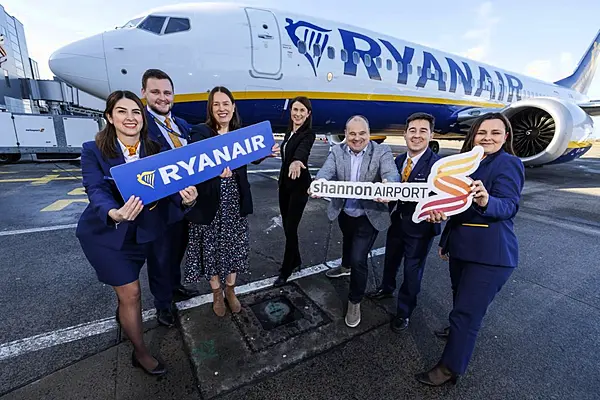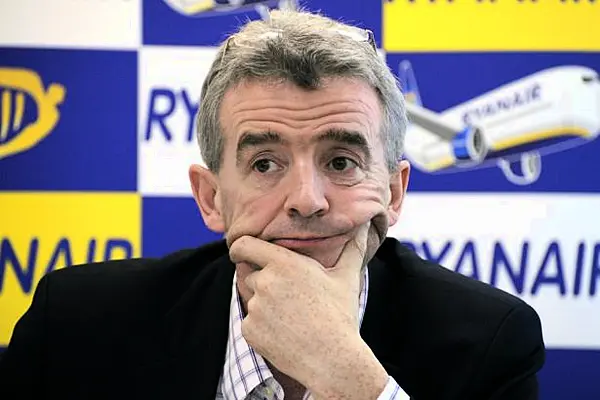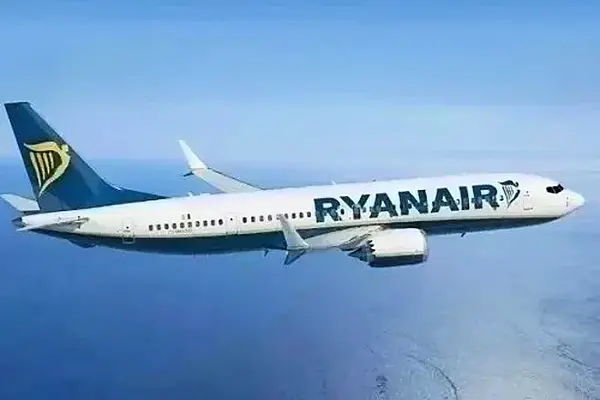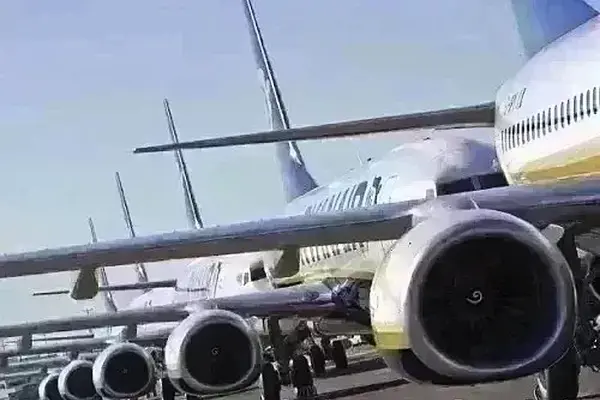Hospitality Ireland presents a round-up of the latest airline and aviation news from around the world.
Jambojet Starts Goma Flights In Africa Expansion
Kenya's first low-cost airline, Jambojet, started a flight service to the eastern Democratic Republic of Congo city of Goma on Friday September 10, it said, looking to tap into a projected jump in demand for air travel in Africa.
The carrier, which was launched in 2014 and is owned by national airline Kenya Airways, expects Africa to become one of the fastest growing regions for aviation in the world in the next two decades, with an average annual expansion of nearly 5%.
"We want to be part of the growth," said Vincent Rague, Jambojet's chairman.
Other Kenyan firms, including its biggest banks Equity and KCB Group, are also expanding into the Democratic Republic of Congo, a relatively untapped market.
Jambojet will fly into Goma, the capital of North Kivu province, twice a week from its Nairobi hub, before increasing to four times a week with time.
The carrier operates a fleet of six De Havilland Dash 8-400 planes and currently serves six local destinations from its Nairobi hub, including popular resort towns along the Kenyan coast.
It embarked on an expansion drive three years ago to double the number of passengers it carries annually, but some of those plans were delayed by the onset of the pandemic early last year.
Aerospace Firms Warn Of Snags Over US Engine Rule Delays
Aerospace companies are urging the United States to speed up a review of rule changes for airplane engines, warning delays in implementing planned global emissions standards could trigger industrial delays.
The warning from the US Aerospace Industries Association (AIA) comes as aerospace firms are more exposed to unexpected regulatory or economic hiccups following the COVID-19 crisis.
The standards would curb the flow of potentially damaging soot particles and do not take effect until the start of 2023.
But executives warn an already overstretched supply chain needs clarity long before then to avoid disruption. And they complain that a process involving two Washington agencies is moving too slowly, while Europe has already taken action.
"Any delay to regulatory implementation would create uncertainty, potentially significantly impacting our supply chain, airline deliveries, and damage US industry’s overall global competitiveness," said Leslie Riegle, AIA assistant vice-president of civil aviation in response to a Reuters query.
The rules must be vetted by the Environmental Protection Agency (EPA), which expects to produce a final rule by September 2022.
But industry officials say the EPA's timetable means the deadline could be placed at risk because the changes must also be signed off by the Federal Aviation Administration (FAA).
It is not clear when the FAA would complete its work, but industry sources say it is likely to take several months. After that, they say, companies would need further time to adapt.
The United States is home to two of the world’s three biggest engine makers, General Electric and Raytheon Technologies Corp's Pratt & Whitney.
GE said it encourages the administration "to accelerate its rule making" so that manufacturers have "clear standards for demonstrating compliance prior to the 2023 deadline."
Pratt & Whitney declined to comment.
Both agencies, EPA and FAA, said that they are working towards completing the process by the time the global standard becomes effective at the beginning of 2023.
Still, questions over whether the deadline will be met have prompted some executives to contemplate an unusual workaround by seeking approvals indirectly from the European Union Aviation Safety Agency (EASA), the FAA's counterpart in Europe.
Such a step is possible because of the interconnected nature of the aerospace industry. But it would need the involvement of the FAA and could create extra work and costs for U.S. manufacturers, a senior industry source said.
The proposal comes at a time when US regulators are seeing their traditional aviation leadership increasingly diluted after a crisis over the design and approval of Boeing's 737 MAX.
"Any actions EASA may take on this matter will be coordinated closely with the FAA," an EASA spokesperson said. The FAA did not immediately reply to a request for comment on the potential workaround.
The UN's International Civil Aviation Organization (ICAO), whose governing council adopted the new global standards in 2020, has said they will reduce the environmental and health impact of sooty emissions known as non-volatile particulate matter.
ICAO cannot impose its will on governments, so the United States, Europe and other countries that produce planes must translate the global engine standards into national rules.
EASA said that European companies had already begun submitting applications aimed at complying with the rules, which apply to engines supplying at least 6,000 pounds of thrust that are in production starting from 2023 and new designs after that.
EasyJet Bid Kicks Off Scramble For Budget Airline Supremacy
Europe's no-frills airlines are heralding a once-in-a-lifetime opportunity to grab market share from traditional carriers struggling to emerge from the pandemic, but each will have to overcome significant challenges to come out on top.
Market leader Ryanair last week saw talks over a mega-plane deal fall apart, while No.2 easyJet is lagging the recovery of its rivals so far.
Smaller Wizz Air has had an audacious bid for easyJet rejected, sources say, a move that would create a much stronger challenger to Ryanair if a deal could be done, but which some analysts think could be a distraction at a time of rapid change.
At stake is potentially the biggest reshaping of Europe's aviation industry for a generation, with low-cost airlines looking to outmanoeuvre heavily indebted traditional carriers as COVID-19 travel restrictions are wound down.
Ireland's Ryanair, with 150 million passengers in the year before the pandemic and 200 Boeing 737 MAX jets on order, had until this week looked set to extend its lead to the end of the decade with a deal for up to 250 more.
But talks collapsed spectacularly on Monday, leaving boss Michael O'Leary - long wedded to both Boeing and a strategy of expanding organically - with few quick options to accelerate growth.
That put the spotlight on Jozsef Varadi, CEO of Hungarian upstart Wizz Air, who sources say has made two bold moves to seize the initiative.
Wizz, which flew just 40 million passengers at its pre-pandemic peak, is in talks to order at least 100 new Airbus jets in addition to the 268 strong fleet it is due to have by 2027, sources told Reuters on Thursday.
Sources also named Wizz as the mystery bidder behind a spurned approach to easyJet, which flew around 100 million passengers a year before the pandemic.
That would tear up Wizz's ultra-low cost gospel of internal expansion at all costs for the sake of a major, instant step-up in scale.
While easyJet said its suitor - which it did not name - was no longer interested, and Wizz declined to comment, the move highlighted the risks of easyJet's very different management approach.
EasyJet has long been a hybrid player, focused on undercutting legacy airlines at established airports, while Wizz and Ryanair shun most hubs and focus on pared back fares that exclude other costs like baggage - the "ultra-low-cost" model.
But some feel easyJet's decision to shrink - it has reduced its fleet by 10% in response to the pandemic - may have left it exposed, making its strategy a tougher sell to investors than the growth stories of its rivals.
More reliant on Britain's slower travel recovery than most of the rest of Europe, easyJet is now also lagging the pick up in business at its main competitors.
EasyJet "are very different from what Wizz Air or Ryanair are offering the market at present. So in that sense they are kind of vulnerable as consolidation efforts occur post-COVID," said Joe Gill, head of origination at brokers Goodbody.
After rejecting the bid, easyJet plans to raise £1.2 billion to stay in the race by funding growth at airports. It now has to convince investors to double down on its more cautious strategy just as a bid raises the prospect of a bolder alternative.
Investor meetings this week are trying to win shareholders over to a dilutive rights issue, the second time easyJet has asked for cash during the crisis. The first time, its top shareholder and founder Stelios Haji-Ioannou did not take part.
EasyJet says the funds will give it the firepower to grab slots at premium airports like Paris Orly, Lisbon, Milan Linate and London's Gatwick.
But investors will be aware that any further COVID-19 restrictions could lead to another wash-out winter, swiftly burning through the new money.
Industry sources say Varadi has long had easyJet in his sights. As well as creating a low-cost giant focused on Airbus planes, a combined Wizz-easyJet would add Wizz's low-cost bases in eastern Europe to prime easyJet hubs at Gatwick, as well as across France, Switzerland and elsewhere in western Europe.
"I think there is room for all three, but the question is, over time ... will Wizz come back again with another effort to deliver the consolidation which I think is practically inevitable," said aviation consultant John Strickland.
With few cards to play, O'Leary on Wednesday September 8 started a game of chicken with Boeing by threatening to forgo any new order from the US plane maker for up to a decade – implying he could happily survive with the 650 or so jets he will have when current deliveries complete in 2025.
Observers see few alternatives to returning to the table with Boeing as relations with Airbus are strained and antitrust issues would likely preclude a bid for easyJet. In fact, O'Leary may welcome an easyJet tie-up as a distraction to Wizz.
"It would be good for Ryanair because it would put up Wizz’s costs," said a senior industry source.
Fuelling the low-cost jostling is the fact the pandemic has tipped the industry balance in their favour and away from network carriers like Air France-KLM, British Airways-owner International Airlines Group (IAG) and Lufthansa.
During the pandemic, a lower cost base and more flexible business model has better protected no-frills players, while difficulties restarting long-haul travel have deepened this advantage.
But the challenge for the budget brigade is to achieve growth in a way that does not dilute their cost advantage - either by overpaying for jets or acquiring a higher cost rival - a point made starkly by Wizz chairman and no-frills airline tycoon Bill Franke before the pandemic.
"Not staying disciplined about the business model and allowing other costs to leak in is the 'path to hell'," Franke told Reuters.
EU Okays Alitalia Successor And Says It Is Not Liable For Illegal Aid
EU competition regulators on Friday September 10 gave the green light to a slimmed down successor to Alitalia and said the new state-owned airline was not liable for repaying €900 million in illegal state aid received by its predecessor.
The approval of Italia Trasporto Aereo (ITA) will be greeted with relief in Rome, which has been negotiating for months to prevent the decision on the €900 million of loans from hindering the launch of the new airline.
Alitalia is unlikely to repay that aid, plus interest, as the carrier's coffers are empty and money it may collect from the sale of assets is not expected to be enough.
ITA will operate with less than half of Alitalia's fleet of aircraft and will only be allowed to take over limited parts of its predecessor's handling and maintenance businesses.
Alitalia's brand and its loyalty programme will be sold in an open tender, said the European Commission, which oversees the EU's competition policy.
The new carrier is due to start flying in place of Alitalia on October 15 and plans to employ only a small part of its predecessor's 11,000 total workforce under a new, less generous labour contract.
The uncertainty over the future of thousands of workers has sparked protests and a demonstration was underway in Rome.
"There must be no redundancies. All the [Alitalia] workers must be loaded on board," said the head of CISL labour union Andrea Cuccello, adding the government should extend for three years a lay-off scheme for more than 7,500 workers.
Unions' representatives will met top officials at Italy's economy ministry at 1300 GMT on Friday September 10 to discuss the issue.
The Italian government has set aside a total of €3 billion for ITA, but on Friday September 10 the Commission only gave a green light to an initial 1.35 billion euros capital injection by Rome into the carrier over the next three years.
The government will need approval from the Commission to inject the remaining €1.65 billion.
Alitalia was put into administration in 2017 after three failed reorganisations in the nine years since privatisation. Last year, as the pandemic foiled a planned sale to investors, the government announced its re-nationalisation.
The government granted it two loans worth a total of 900 million euros in 2017 and additional funding worth €400 million in 2019, which is also under investigation by the EU.
The Commission's assessment of Alitalia's balance sheet at the time showed Alitalia was unlikely to be able to generate enough cash to repay the loans, nor could it sell its assets to raise enough cash for the debt repayment, the EU said.
That is the main reason why Brussels ruled the public funds were illegal state aid.
"The two public loans worth 900 million euros granted by Italy to Alitalia gave the company an unfair advantage over its competitors. They must now be recovered by Italy," EU Competition head Margrethe Vestager said in a statement.
SpaceX Prepares To Send First All-Civilian Crew Into Orbit
Yet another billionaire entrepreneur is set to ride into space this week, strapped inside the capsule of a SpaceX rocketship as part of an astro-tourist team poised to make history as the first all-civilian crew launched into Earth orbit.
Jared Isaacman, the American founder and chief executive of e-commerce firm Shift4 Payments, will lead three fellow spaceflight novices on a three-day trip from blastoff at Cape Canaveral, Florida, to splashdown in the Atlantic.
The 38-year-old tech mogul has plunked down an unspecified but presumably exorbitant sum for fellow billionaire and SpaceX owner Elon Musk to fly Isaacman and three specially selected travel mates into orbit aboard a SpaceX Crew Dragon capsule.
The crew vehicle, dubbed Resilience, was set for liftoff from NASA's Kennedy Space Center atop one of Musk's reusable Falcon 9 rockets, with a five-hour targeted launch window that opens at 8 p.m. EDT (0000 GMT) on Wednesday.
Forecasts on Sunday predicted a 70% chance of favorable weather conditions for launch, organizers said, on a flight directed entirely from the ground.
A successful flight could spawn a new era of commercial space tourism, with several firms vying for wealthy customers to pay a small fortune to experience the exhilaration of supersonic travel, weightlessness and the visual spectacle of space.
Setting acceptable levels of consumer risk in the inherently dangerous endeavor of rocket travel is also key, and raises a pointed question.
"Do you have to be both rich and brave to get on these flights right now?" Sridhar Tayur, a professor of operations management and new business models at Carnegie Mellon University in Pittsburgh, asked in an interview with Reuters on Friday.
The so-called Inspiration4 mission was conceived by Isaacman mainly to raise awareness and support for one of his favorite causes, St. Jude Children's Research Hospital, a leading pediatric cancer center.
He has pledged $100 million personally to the institute.
SpaceX is easily the most well-established player in the burgeoning constellation of commercial rocket ventures, having already launched numerous cargo payloads and astronauts to the International Space Station for NASA.
Rival companies Virgin Galactic and Blue Origin both recently celebrated their debut astro-tourism missions with their respective founding executives, billionaires Richard Branson and Jeff Bezos, each going along for the ride.
But those two high-profile flights were suborbital in scale, sending their crews of citizen astronauts to space and back in a matter of minutes.
The SpaceX flight is designed to carry its four passengers where no all-civilian crew has gone before, into Earth orbit.
There, they will circle the globe once every 90 minutes at more than 17,000 mph (27,360 kph), or roughly 22 times the speed of sound. The target altitude is 575 kilometers, or nearly 360 miles, beyond the orbits of the International Space Station or even the Hubble Space Telescope.
Like Blue Origin, the 20-story-tall SpaceX launch vehicle and crew capsule will take off vertically from a launch pad on a flight directed entirely from the ground.
Branson's suborbital rocket plane, by contrast, had two highly trained pilots at the controls as it carried its four rear-seat passengers 50 miles (81 km) high.
The Inspiration4 crew will have no part to play in operating their spacecraft, despite some largely honorary titles, though two, Isaacman and geoscientist Sian Proctor, are licensed pilots.
Isaacman, who is rated to fly commercial and military jets, has assumed the role of mission "commander," while Proctor, 51, once a NASA astronaut candidate herself, has been designated as the mission "pilot."
She was selected to join the team through an online contest run by Shift4 Payments.
Rounding out the crew are "chief medical officer" Hayley Arceneaux, 29, a bone cancer survivor turned St. Jude physicians' assistant, and mission "specialist" Chris Sembroski, 42, a US Air Force veteran and aerospace data engineer.
Sembroski won a seat in a sweepstake that drew 72,000 applicants and has raised more than $100 million in St. Jude donations.
The four crewmates have spent five months making rigorous preparations, including altitude fitness, centrifuge (G-force), microgravity and simulator training, emergency drills, classroom work and medical exams.
SpaceX and the crew planned a full dress-rehearsal of launch-day activities at the Cape on Sunday night, to be followed by a final "static" test firing of the rocket's engines, organizers said.
Inspiration4 officials stress that the mission is more than a joyride.
Once in orbit, the crew will perform medical experiments with "potential applications for human health on Earth and during future spaceflights," the group said in media materials.
Appearing in a promotional clip for a Netflix documentary series on the mission, Arceneaux said a big part of her motivation was to kindle hope in her cancer patients.
"I'm getting to show them what life can look like after cancer," she said.
SpiceJet Settles With Boeing MAX Aircraft Lessor CDB Aviation
Budget airline SpiceJet said on Monday September 13 that it has settled with another lessor of Boeing Co's MAX aircraft, CDB Aviation, as it looks to start operating the aircraft by the end of September after India cleared the 737 MAX to fly last month.
The 737 MAX was grounded worldwide in March 2019 after two fatal crashes in five months killed 346 people, plunging Boeing into a financial crisis, which has since been compounded by the pandemic.
In August, India's air safety regulator, the Directorate General of Civil Aviation, said it cleared 737 MAX aircraft to fly with immediate effect, after nearly two-and-a-half years of regulatory grounding.
SpiceJet said in August it expected the grounded 737 MAX jets in its fleet to return to service at the end of September after a settlement with lessor Avolon on leases of the aircraft.
The lifting of the ban in India came months after the aircraft returned to service in the United States and Europe. More recently grounding orders were lifted in other countries, including Australia, Fiji, Japan and Malaysia.
The resumption of MAX aircraft services would be subject to regulatory approvals https://www.bseindia.com/xml-data/corpfiling/AttachLive/481721b3-6aca-4ef7-a16f-c9b0d41c0132.pdf, SpiceJet, India's second-largest airline by market share and the only one in the country to fly the aircraft, said.
China is the biggest market in the region that has yet to approve the return of the 737 MAX, though Boeing last month conducted test flights in the country.
SpiceJet's shares were up 0.3% on Monday September 13, while rival Indigo's owner InterGlobe Aviation was down nearly 2%.
India's Jet Airways To Resume Domestic Operations In First Quarter Of 2022
Jet Airways will resume domestic operations by the first quarter of 2022, an investor consortium, whose resolution plan was approved by India's bankruptcy court earlier this year, said on Monday September 13.
Once India's biggest private carrier, Jet stopped flying in April 2019 after running out of cash, owing billions to lenders and leaving thousands without jobs.
The defunct airline had said in June that the National Company Law Tribunal (NCLT) approved a resolution plan submitted by a consortium of London-based Kalrock Capital and UAE-based businessman Murari Lal Jalan.
The bankruptcy court's go-ahead came several months after Jet's creditors had given their approval in October last year to the resolution plan submitted by the consortium.
"Jet Airways 2.0 aims at restarting domestic operations by Q1 2022, and short haul international operations by Q3/Q4 2022," Murari Lal Jalan, lead member of the Jalan Kalrock Consortium and the proposed non-executive chairman of Jet Airways, said.
Jet, which operated a fleet of more than 120 planes serving dozens of domestic destinations and international hubs such as Singapore, London and Dubai, said it has already hired over 150 full-time employees and is looking to onboard another 1,000 employees in FY 2021-22 across categories.
Shares of Jet Airways hit their upper circuit and were trading at 84.40 rupees a piece.
Asian Airline Group's Members Commit To Net Zero Emissions By 2050
Association of Asia Pacific Airlines (AAPA) members have joined the growing list of global carriers committed to net zero carbon emissions by 2050, the group's head said on Monday September 13.
AAPA members are full-service airlines based in South East Asia, Japan, South Korea, Taiwan and Hong Kong.
"It is a challenging goal, but we are committed to this," AAPA director general Subhas Menon told reporters.
He said that the target could be met through fuel efficiency improvements, operations and infrastructure initiatives, carbon offsets and promoting sustainable aviation fuels.
Some AAPA members including Singapore Airlines Ltd, Cathay Pacific Airways Ltd, Japan Airlines Co Ltd and ANA Holdings Inc had already announced plans for net zero emissions by 2050.
News by Reuters, edited by Hospitality Ireland. Click subscribe to sign up for the Hospitality Ireland print edition.









